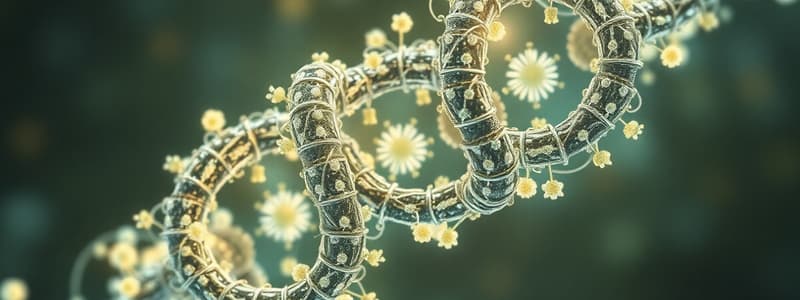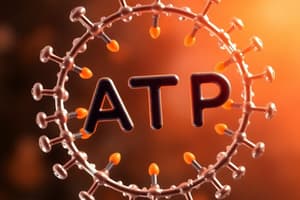Podcast
Questions and Answers
What is the primary function of ATP in cells?
What is the primary function of ATP in cells?
- Storing genetic information
- Transporting molecules across cell membranes
- Providing structural support
- Providing energy for cellular processes (correct)
What happens to ATP when energy is released?
What happens to ATP when energy is released?
- It is converted into glucose
- It is converted into ADP and a phosphate group (correct)
- It is stored as glycogen
- It is broken down into carbon dioxide and water
What is the primary source of energy that is used to make ATP?
What is the primary source of energy that is used to make ATP?
- Water
- Food (correct)
- Sunlight
- Carbon dioxide
Which of the following macromolecules is the most readily broken down for ATP production?
Which of the following macromolecules is the most readily broken down for ATP production?
Which of the following statements about ATP production is TRUE?
Which of the following statements about ATP production is TRUE?
What is the main function of ATP?
What is the main function of ATP?
What happens to ATP when a phosphate group is removed?
What happens to ATP when a phosphate group is removed?
Which of the following is NOT a component of ATP?
Which of the following is NOT a component of ATP?
What is the process called when a phosphate group is added to ADP to make ATP?
What is the process called when a phosphate group is added to ADP to make ATP?
What is the main source of energy used to add a phosphate group to ADP?
What is the main source of energy used to add a phosphate group to ADP?
How is ADP recycled?
How is ADP recycled?
What is the role of the enzyme ATP Synthase?
What is the role of the enzyme ATP Synthase?
How does the ATP-ADP cycle contribute to the flow of energy within a cell?
How does the ATP-ADP cycle contribute to the flow of energy within a cell?
Flashcards
ATP Breakdown
ATP Breakdown
ATP releases energy, becoming ADP and a phosphate.
ATP Formation
ATP Formation
ADP and phosphate combine with energy to form ATP.
Exothermic Reaction
Exothermic Reaction
Reactions that release more energy than they require.
Endothermic Reaction
Endothermic Reaction
Signup and view all the flashcards
Energy Sources for ATP
Energy Sources for ATP
Signup and view all the flashcards
ATP
ATP
Signup and view all the flashcards
Photosynthesis
Photosynthesis
Signup and view all the flashcards
Cellular Respiration
Cellular Respiration
Signup and view all the flashcards
ADP
ADP
Signup and view all the flashcards
ATP-ADP Cycle
ATP-ADP Cycle
Signup and view all the flashcards
Chemiosmosis
Chemiosmosis
Signup and view all the flashcards
ATP Synthase
ATP Synthase
Signup and view all the flashcards
Energy Bonds
Energy Bonds
Signup and view all the flashcards
Study Notes
Adenosine Triphosphate (ATP)
- ATP is the main energy currency for cells
- It stores energy in chemical bonds
- Body cannot directly use food for energy. Energy in food is stored in chemical bonds
- Energy is converted into a usable form by breaking bonds and forming new ones
- ATP carries this usable energy for cell functions
SB1 Learning Objectives
- Analyze relationships between structures and functions in living cells
- Investigate and explain the roles of photosynthesis and respiration in the cycling of matter and energy flow within cells (e.g., single-celled algae)
- Focus on understanding inputs, outputs, and functions of photosynthesis and respiration, including major sub-processes
ATP Structure
- Nitrogen base (adenine)
- Sugar ring (ribose)
- Three phosphate groups held together by high-energy bonds
ATP-ADP Cycle
- Energy is stored in the bond between the last two phosphates
- Energy is released when a phosphate group is removed
- ADP becomes ATP when a phosphate group is added
- ADP is recycled
- This is a chemiosmotic process, involving movement of ions down a concentration gradient
- Enzyme ATP synthase adds the third phosphate to ADP using energy from the food
ATP Formation
- Cells join ADP and a phosphate together using energy from food
- This is an endothermic reaction (energy is absorbed)
- ATP breakdown is an exothermic reaction (energy is released)
Sources of Energy for ATP Production
- Carbohydrates are the primary source
- ~36 ATP can be produced from one glucose molecule
- Carbohydrates store 4 calories per gram of energy
- Lipids (fats) are a secondary source
- Lipids store 9 calories per gram of energy
- Proteins are the least likely source for energy and store 4 calories per gram of energy
ATP Model
- Practice putting the information together
Studying That Suits You
Use AI to generate personalized quizzes and flashcards to suit your learning preferences.




